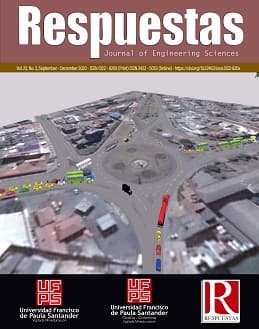Computational analysis of hybrid heating of a heterogeneous core-shell configuration for improving temperature uniformity
Análisis computacional del calentamiento híbrido de una configuración heterogénea de núcleo-caparazón para mejorar la uniformidad de la temperatura
Main Article Content
Throughout this study, we propose using hybrid heating (microwaves – thermal radiation) on a heterogeneous structure. Our goal is to improve the effectivity of its thermal treatment. We analyze a core-shell assembly with different thermal and electrical properties. A solid sphere makes up the core of the arrangement. Such a core is surrounded by three layers of different materials. Because of the properties of the original system, we propose modifying the core so that it absorbs microwaves. The layers are all homogeneous and microwave transparent. The first two exhibit a low thermal conductivity, while the outermost one is a good thermal conductor. We also propose adding a thin layer of susceptor between the first two layers, striving to alleviate the low thermal conduction problem. Furthermore, the dielectric loss constant of this new layer is temperature-dependent. We assume that the composed sphere hangs within the electromagnetic cavity and continuously rotates, so it homogeneously receives microwaves and thermal radiation (from an electrical resistance). Thus, the thermal model is given by a set of time-dependent partial differential equations. Transient temperature profiles are analyzed under different experimental scenarios. There is a clear advantage of using the proposed hybrid heating in this particular case.
Downloads
Publication Facts
Reviewer profiles N/A
Author statements
Indexed in
- Academic society
- Universidad Francisco de Paula Santander
- Publisher
- Universidad Francisco de Paula Santander
Article Details
J. Sun, W. Wang, and Q. Yue, “Review on Microwave-Matter Interaction Fundamentals and Efficient Microwave-Associated Heating Strategies,” Materials (Basel)., vol. 9, no. 4, 2016.
Z. Song et al., “Microwave drying performance of single-particle coal slime and energy consumption analyses,” FUEL Process. Technol., vol. 143, pp. 69–78, Mar. 2016.
W. Wang et al., “Quantitative measurement of energy utilization efficiency and study of influence factors in typical microwave heating process,” ENERGY, vol. 87, pp. 678–685, Jul. 2015.
R. Roy, R. Peelamedu, L. Hurtt, J. P. Cheng, and D. Agrawal, “Definitive experimental evidence for Microwave Effects: radically new effects of separated E and H fields, such as decrystallization of oxides in seconds,” Mater. Res. Innov., vol. 6, no. 3, pp. 128–140, Sep. 2002.
K. Kashimura, H. Sugawara, M. Hayashi, T. Mitani, and N. Shinohara, “Microwave heating behavior and microwave absorption properties of barium titanate at high temperatures,” AIP Adv., vol. 6, no. 6, Jun. 2016.
H. Sugawara et al., “Temperature dependence and shape effect in high-temperature microwave heating of nickel oxide powders,” Phys. B-CONDENSED MATTER, vol. 458, pp. 35–39, Feb. 2015.
H. Zhu, T. Gulati, A. K. Datta, and K. Huang, “Microwave drying of spheres: Coupled electromagnetics-multiphase transport modeling with experimentation. Part I: Model development and experimental methodology,” FOOD Bioprod. Process., vol. 96, pp. 314–325, Oct. 2015.
A. J. Buttress et al., “Design and optimisation of a microwave reactor for kilo-scale polymer synthesis,” Chem. Eng. Sci. X, vol. 2, 2019.
M. Kumar, D. M. Phase, and R. J. Choudhary, “Structural, ferroelectric and dielectric properties of multiferroic YMnO3 synthesized via microwave assisted radiant hybrid sintering,” HELIYON, vol. 5, no. 5, May 2019.
R. I. Badiger, S. Narendranath, and M. S. Srinath, “Optimization of Process Parameters by Taguchi Grey Relational Analysis in Joining Inconel-625 Through Microwave Hybrid Heating,” Metallogr. Microstruct. Anal., vol. 8, no. 1, pp. 92–108, Feb. 2019.
N. M. Maliessa and S. R. A. Idris, “Effect of Different Amount of Silicon Carbide on SAC Solder-Cu Joint Performance by Using Microwave Hybrid Heating Method,” in IOP Conference Series: Materials Science and Engineering, 2019, vol. 469, no. 1.
N. Chhanwal, P. R. Bhushette, and C. Anandharamakrishnan, “Current Perspectives on Non-conventional Heating Ovens for Baking Process—a Review,” Food Bioprocess Technol., vol. 12, no. 1, 2019.
S. L. Marahadige, S. M. Sridharmurthy, A. H. Jayraj, U. S. Mahabaleshwar, G. Lorenzini, and E. Lorenzini, “Development of copper alloy by microwave hybrid heating technique and its characterization,” Int. J. HEAT Technol., vol. 36, no. 4, pp. 1343–1349, 2018.
A. C. Meredith R. J.; Metaxas, Industrial microwave heating. Peter Peregrinus, 1993.








